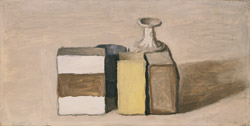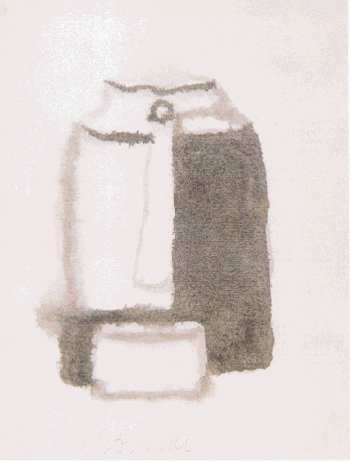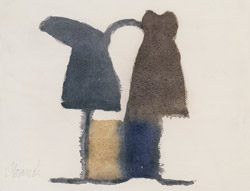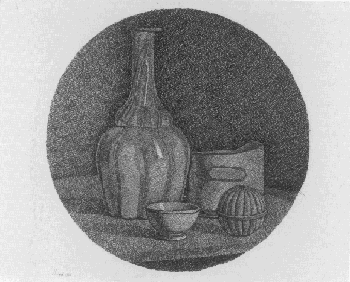 Mrs. T departed for Connecticut last Friday morning, and I promptly hurled myself into a frenzy of urban activity. It was a brilliant and balmy weekend in New York City, the best of all possible times to be out and about, and so I spent very little time at home. On Friday evening I saw To Be or Not to Be on Broadway. The next morning I went to the gym, dropped by Mr. JazzWax‘s apartment to listen to records, visited two art galleries, and returned to Broadway to see Katie Holmes make her stage debut in Arthur Miller’s All My Sons. On Sunday I took a brisk walk through Central Park, ending up at the Metropolitan Museum of Art, where I spent an hour looking at paintings, then returned to the Upper West Side to dine at Good Enough to Eat, where I hadn’t eaten for weeks. Walking through the front door felt a little like coming home after a sea voyage.
Mrs. T departed for Connecticut last Friday morning, and I promptly hurled myself into a frenzy of urban activity. It was a brilliant and balmy weekend in New York City, the best of all possible times to be out and about, and so I spent very little time at home. On Friday evening I saw To Be or Not to Be on Broadway. The next morning I went to the gym, dropped by Mr. JazzWax‘s apartment to listen to records, visited two art galleries, and returned to Broadway to see Katie Holmes make her stage debut in Arthur Miller’s All My Sons. On Sunday I took a brisk walk through Central Park, ending up at the Metropolitan Museum of Art, where I spent an hour looking at paintings, then returned to the Upper West Side to dine at Good Enough to Eat, where I hadn’t eaten for weeks. Walking through the front door felt a little like coming home after a sea voyage.
 You’ve probably guessed that I spent a good-sized chunk of the weekend looking at the paintings, watercolors, and etchings of Giorgio Morandi, which are currently on display at the Met, Pace Master Prints, and Lucas Schoormans Gallery. My trip to the Met wasn’t quite as satisfying as I’d hoped, however, though not because of the show, which isn’t quite perfect–the choice of etchings is less than representative–but comes close enough to be unforgettable. The problem is that the curators of the show made the inexplicable and irreparable mistake of installing it in a high-traffic area that is mere steps away from the museum’s new downstairs cafeteria. As a result, “Giorgio Morandi, 1890-1964” is drawing large numbers of people who would rather talk than look at art, not a few of whom seem unaware that the use of a cellphone within five hundred yards of a Morandi still life would be punishable by death and/or dismemberment if I had anything to do with it.
You’ve probably guessed that I spent a good-sized chunk of the weekend looking at the paintings, watercolors, and etchings of Giorgio Morandi, which are currently on display at the Met, Pace Master Prints, and Lucas Schoormans Gallery. My trip to the Met wasn’t quite as satisfying as I’d hoped, however, though not because of the show, which isn’t quite perfect–the choice of etchings is less than representative–but comes close enough to be unforgettable. The problem is that the curators of the show made the inexplicable and irreparable mistake of installing it in a high-traffic area that is mere steps away from the museum’s new downstairs cafeteria. As a result, “Giorgio Morandi, 1890-1964” is drawing large numbers of people who would rather talk than look at art, not a few of whom seem unaware that the use of a cellphone within five hundred yards of a Morandi still life would be punishable by death and/or dismemberment if I had anything to do with it.
 I’m sure, by the way, that I beamed benevolently at some of the very same people when I saw them in Central Park a few minutes earlier. Parks are supposed to be crowded on balmy Sunday afternoons, and I enjoyed every minute of my long walk from the West Side to the East Side. But a park is by definition open to all comers, a gathering place for the demos. An art museum is a trickier proposition. I know that I ought to want the Metropolitan Museum to be crowded seven days a week, that it should be a sign of cultural health for its galleries to be packed. I also know what it’s like to visit a museum that time and demography have passed by. In 2003 I paid a weekday visit to the Newark Museum and was shocked to find myself the only person in the galleries other than the guards. I would never want that to happen to the Met.
I’m sure, by the way, that I beamed benevolently at some of the very same people when I saw them in Central Park a few minutes earlier. Parks are supposed to be crowded on balmy Sunday afternoons, and I enjoyed every minute of my long walk from the West Side to the East Side. But a park is by definition open to all comers, a gathering place for the demos. An art museum is a trickier proposition. I know that I ought to want the Metropolitan Museum to be crowded seven days a week, that it should be a sign of cultural health for its galleries to be packed. I also know what it’s like to visit a museum that time and demography have passed by. In 2003 I paid a weekday visit to the Newark Museum and was shocked to find myself the only person in the galleries other than the guards. I would never want that to happen to the Met.
 Alas, the experience of high art is democratic only in theory, never in practice, which is why there is something inherently contradictory, perhaps even deeply wrong, about seeing crowds at an exhibition of the paintings of Giorgio Morandi. Morandi is a difficult painter, one whose still lifes inevitably strike the casual viewer as both repetitive and plain. They require close, quiet attention in order to be appreciated. Giorgio Morandi: The Art of Silence is the apt title of a monograph about Morandi published a couple of years ago. It is inconceivable that anyone capable of talking in the presence of Morandi’s late watercolors, which are so concentrated and oblique as to border on outright abstraction, could possibly be appreciating them.
Alas, the experience of high art is democratic only in theory, never in practice, which is why there is something inherently contradictory, perhaps even deeply wrong, about seeing crowds at an exhibition of the paintings of Giorgio Morandi. Morandi is a difficult painter, one whose still lifes inevitably strike the casual viewer as both repetitive and plain. They require close, quiet attention in order to be appreciated. Giorgio Morandi: The Art of Silence is the apt title of a monograph about Morandi published a couple of years ago. It is inconceivable that anyone capable of talking in the presence of Morandi’s late watercolors, which are so concentrated and oblique as to border on outright abstraction, could possibly be appreciating them.
 My Saturday visits to Pace Master Prints and Lucas Schoormans Gallery were a different story. I spent a half-hour looking at the two dozen etchings on display at Pace Master Prints, and throughout that time I was the only person in the gallery devoted to Morandi. I was glad to be alone–but troubled, too, by the fact that no one else in New York City was there. Morandi, after all, was one of the greatest printmakers of the twentieth century, a master of his infinitely subtle medium, and the Pace show is a once-in-a-lifetime experience, an indispensable pendant to the Met retrospective. How is it possible that so important an exhibition should have drawn only a single viewer at midday on a Saturday in October? Be careful what you ask for, I thought as I left the gallery.
My Saturday visits to Pace Master Prints and Lucas Schoormans Gallery were a different story. I spent a half-hour looking at the two dozen etchings on display at Pace Master Prints, and throughout that time I was the only person in the gallery devoted to Morandi. I was glad to be alone–but troubled, too, by the fact that no one else in New York City was there. Morandi, after all, was one of the greatest printmakers of the twentieth century, a master of his infinitely subtle medium, and the Pace show is a once-in-a-lifetime experience, an indispensable pendant to the Met retrospective. How is it possible that so important an exhibition should have drawn only a single viewer at midday on a Saturday in October? Be careful what you ask for, I thought as I left the gallery.
Things were different in yet another, more benign way when I arrived at Lucas Schoormans Gallery, whose Morandi show seems to me to be just about perfect. Instead of a hundred paintings and works on paper, there were a couple of dozen carefully chosen pieces on display. Instead of a clamorous horde of visitors–or none–there were six or seven people whose rapt, uncasual silence spoke for itself. Not for a moment did I doubt that they were there for the right reasons. Yet they had passed no test to be admitted: Lucas Schoormans Gallery, like Central Park, is open to all comers, not just to wealthy collectors or accredited connoisseurs. To partake of its offerings is, in the truest and best sense of the word, a democratic experience.
As for the Met, it is…well, the Met. While no great museum gets everything right, the Metropolitan Museum of Art, like the Phillips Collection, comes far closer than most. I am blessed to be within comfortable walking distance of its front door, and I expect to go back to see its Morandi exhibition several more times–but never again on a Sunday afternoon. It is possible to believe in the necessity of democracy without feeling the need to idealize it.
* * *
Lucas Schoormans Gallery’s “Giorgio Morandi: Paintings and Works on Paper” and Pace Master Prints’ “The Etchings of Giorgio Morandi” both close on Saturday. For more information, go here and here.
“Giorgio Morandi, 1890-1964” is up at the Met through December 14.
